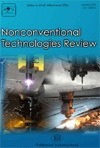INFLUENCE OF WELDING PARAMETERS ON WELD BEAD GEOMETRY IN LASER BEAM WELDING OF CARBON STEEL ST 37
Abstract
Laser beam welding (LBW) is a non-conventional joining technology widely used in industry due to its advantages, such as a small heat-affected zone (HAZ) and high precision. Welding quality is influenced by several parameters, including welding
speed, shielding gas flow rate, and the distance between the components being welded. This study aims to investigate the influence of welding parameters on weld bead geometry and HAZ in the laser beam welding of carbon steel St 37, without filler material. The paper demonstrates the importance of optimizing welding parameters to achieve a high-quality weld in carbon steel St 37. Laser
welding experiments were conducted using an XT Laser 1.5kW Handheld Fiber Laser Welding Machine, mounted on a monoaxial automatic displacement device. Welding parameters such as welding speed, argon flow rate, and distance between the welded plates were varied, while keeping other parameters constant. The dimensions of the welded bead and HAZ were measured on cross-sections
of the welded specimens. The experimental results showed that the dimensions of the weld bead and HAZ increase with decreasing welding speed and increasing argon flow rate. The distance between the welded plates negatively influences the shape of the bead; an excessive distance leads to a concave bead profile with reduced mechanical strength. These findings emphasize the need for precise
control of welding parameters to achieve high-quality joints.
References
2. Gonçalves, L.F., Duarte, F.M., Martins, C.I. and Paiva, M.C., Laser welding of thermoplastics: An overview on lasers, materials, processes and quality. Infrared Physics & Technology, 119, p.103931 (2021)
3. Cai, W., Wang, J., Jiang, P., Cao, L., Mi, G. and Zhou, Q., Application of sensing techniques and 15 artificial intelligence-based methods to laser welding real-time monitoring: A critical review of recent literature. Journal of Manufacturing
systems, 57, pp.1-18 (2020).
4. Shin, Y.C., Wu, B., Lei, S., Cheng, G.J. and Lawrence Yao, Y., Overview of laser applications in manufacturing and materials processing in recent years. Journal of Manufacturing Science and Engineering, 142(11), p.110818, (2020).
5. Slobodyan, M., Resistance, electron-and laser-beam welding of zirconium alloys for nuclear applications: a review. Nuclear Engineering and Technology, 53(4), pp.1049-1078, (2021).
6. Mirak, A., Shams, B. and Bakhshi, S., Dissimilar welding of Inconel 713 superalloy and AISI 4140 steel using Nd: YAG pulse laser: An investigation on the microstructure and mechanical properties. Optics & Laser Technology, 152, p.108143 (2022).
7. Gajbhiye, A.M., Sonawane, P.R., Karle, A.H. and Campli, S., Optimization of welding parameters for En8D and SAE1018 materials by Taguchi. International Journal on Interactive Design and Manufacturing (IJIDeM), pp.1-10 (2023).
8. Kumar, B., Bag, S., Paul, C.P., Das, C.R., Ravikumar, R. and Bindra, K.S., Influence of the mode of laser welding parameters on microstructural morphology in thin sheet
Ti6Al4V alloy. Optics & Laser Technology, 131, p.106456 (2020).
9. Haupt, W., Borges, L.G., Israel, C.L. and Riffel, K.C., Effects of laser welding on the mechanical properties and microstructure of AISI 304 stainless steel. Lasers in Manufacturing and Materials Processing, pp.1-18 (2024).
10. Errico, V., Campanelli, S.L., Angelastro, A., Mazzarisi, M. and Casalino, G., On the feasibility of AISI 304 stainless steel laser welding with metal powder. Journal of Manufacturing Processes, 56, pp.96-105 (2020).
11. Omoniyi, P.O., Mahamood, R.M. and Akinlabi, E.T., Impact of process parameters of laser welding on the mechanical properties of Ti6Al4V: A review. J. Chem. Technol.
Metall, 56, pp.1074-1081 (2021).
12. Far, M.N.S., Farsibaf, M.M., Kolahan, F. and Elhami, S., Analyzing weld bead geometry and microstructure in ultrasonic-assisted activated flux TIG welding of ST37 steel. International Journal on Interactive Design and Manufacturing (IJIDeM), pp.1-14 (2024).
13. Vuherer, T., Milčić, M., Glodež, S., Milčić, D., Radović, L. and Kramberger, J., Fatigue and fracture behaviour of Friction Stir Welded AA-2024-T351 joints. Theoretical and Applied Fracture Mechanics, 114, p.103027 (2021).
14. Wang, C.Y., Jiang, M.H., Wang, C.D., Liu, H.H., Zhao, D. and Chen, Z.L., Modeling three-dimensional rough surface and simulation of temperature and flow field in laser transmission welding. Journal of Advanced Joining Processes, 1, p.100021 (2020).
15. Perka, A.K., John, M., Kuruveri, U.B. and Menezes, P.L., Advanced high-strength steels for automotive applications: arc and laser welding process, properties, and
challenges. Metals, 12(6), p.1051 (2022).
16. Deepak, J.R., Anirudh, R.P. and Sundar, S.S., Applications of lasers in industries and laser welding: A review. Materials Today: Proceedings (2023).

